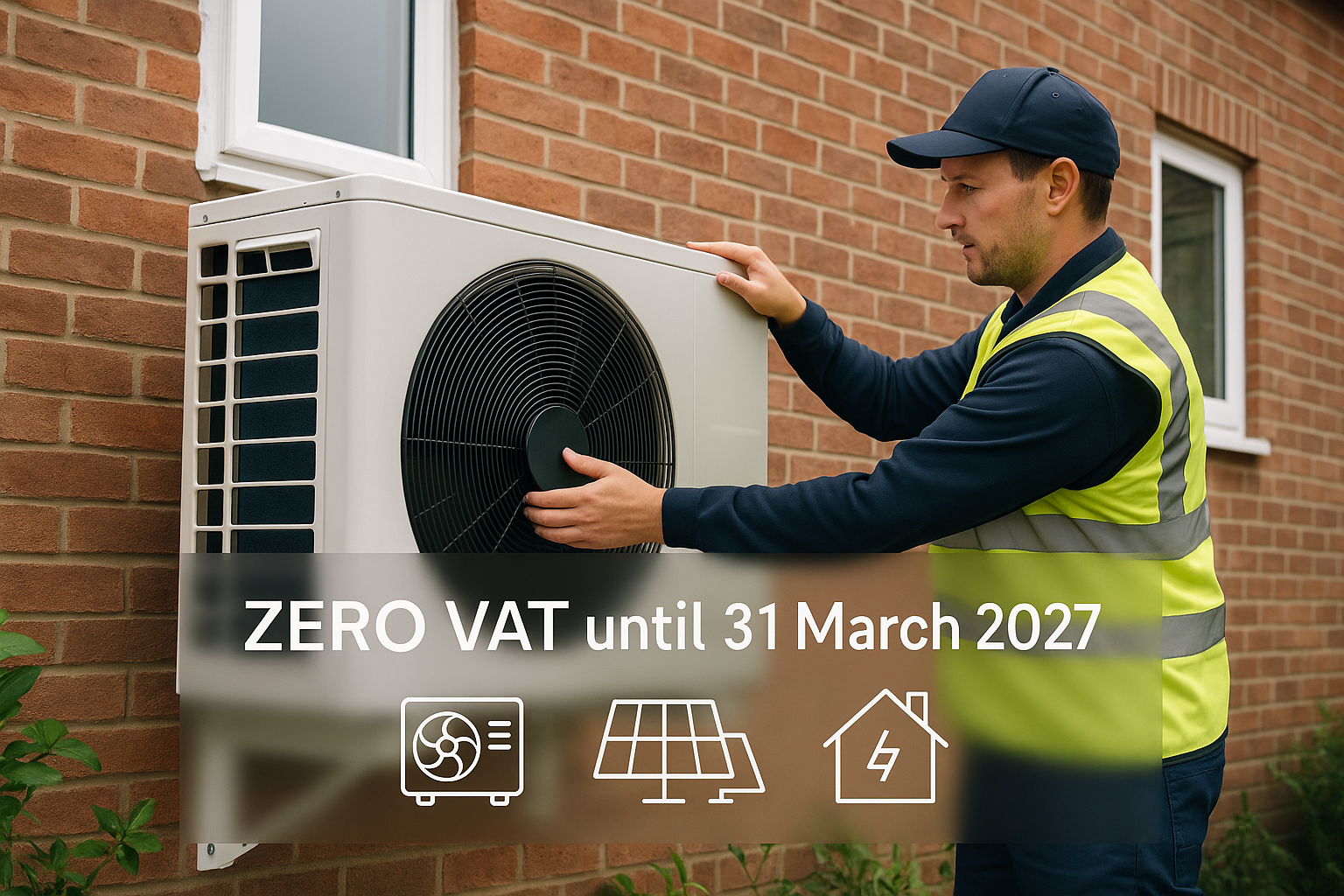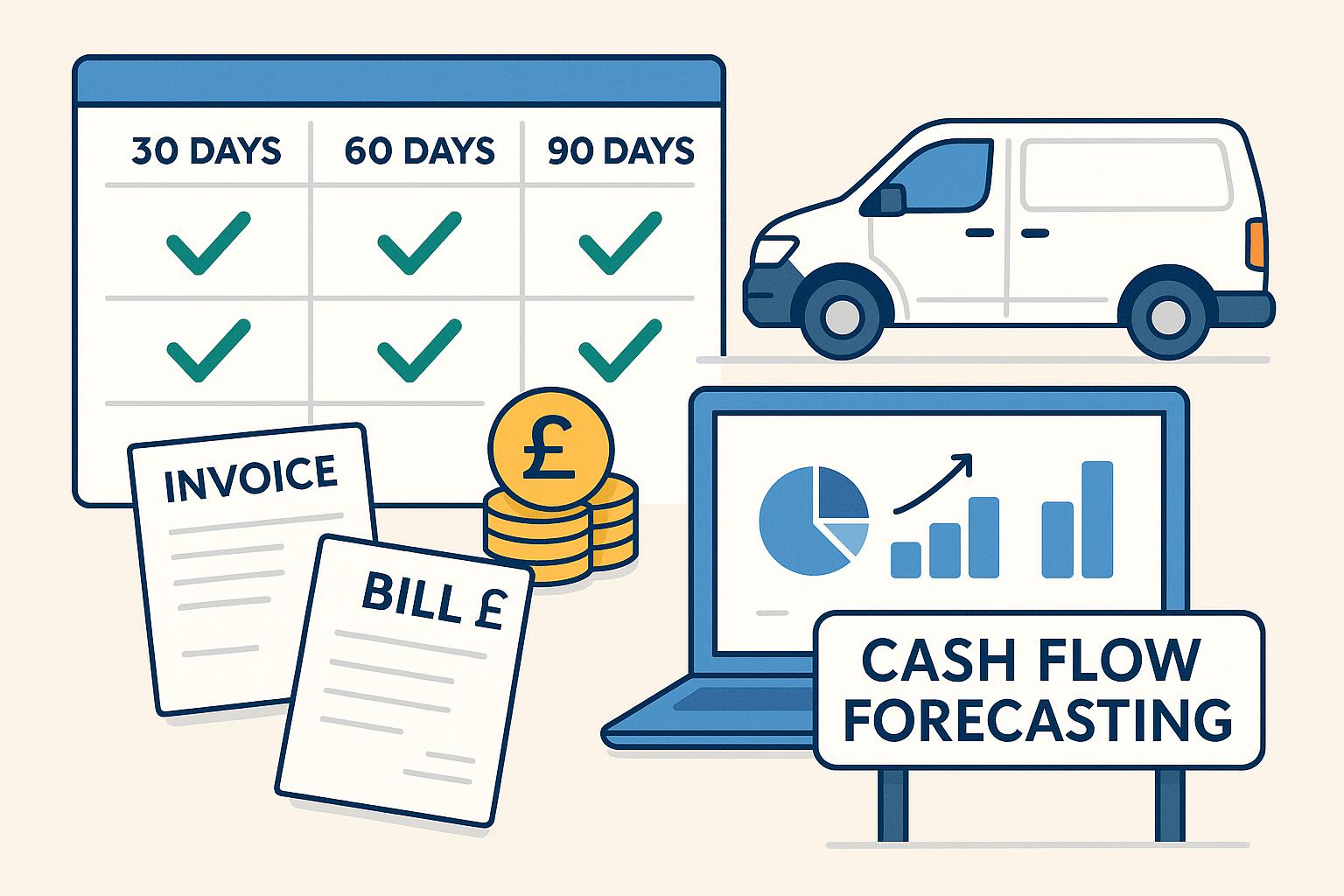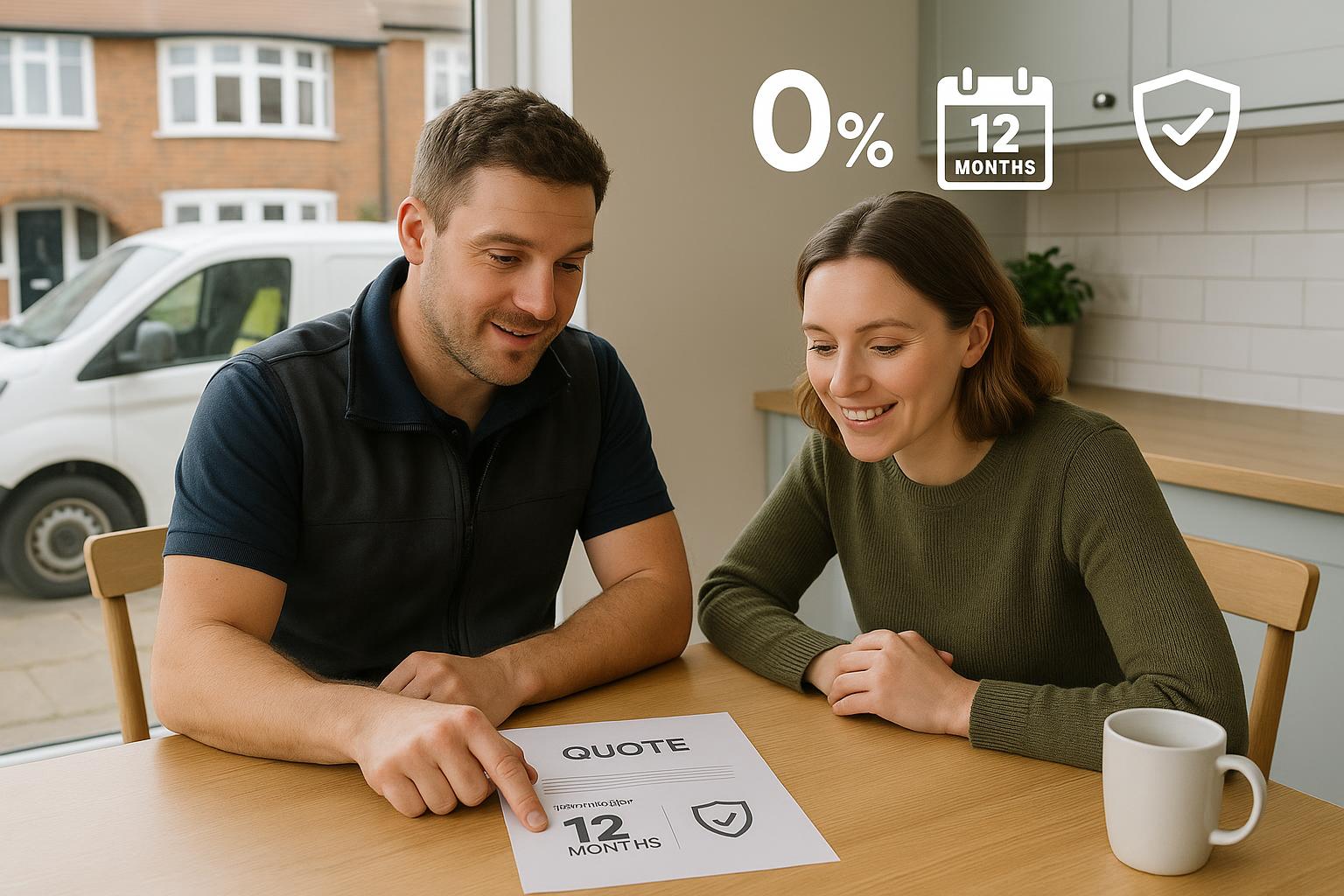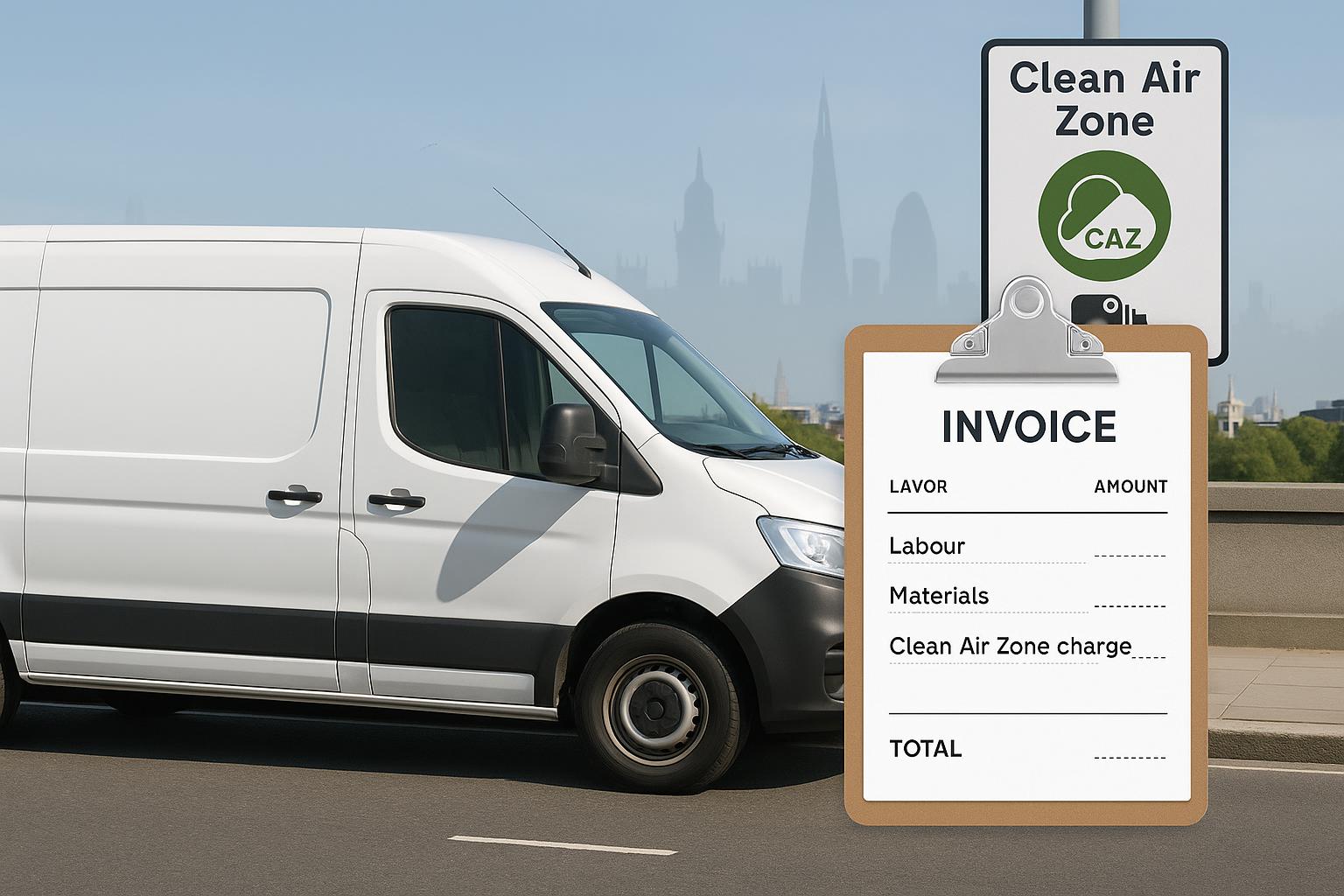
0% VAT on energy‑saving materials: what installers need to know, invoice wording and examples
What counts • Decision flow • Invoice wordin...
Category: Finance & Tax • Niche: VAT, energy efficiency, heat pumps, solar
- Contents: Quick answer • What counts • Decision flow • Invoice wording • Edge cases • Common job scenarios • Evidence to keep • Pricing tips • Video explainer • Useful links • FAQs
Quick answer
- From 1 April 2022 to 31 March 2027, the installation of qualifying energy saving materials in homes and certain charitable buildings is zero rated for VAT. After 1 April 2027 it reverts to 5 percent unless the law changes.
- It is the installation that is relieved. Supply only of materials is standard rated.
- Typical qualifying tech includes heat pumps, solar panels, insulation and, from 1 Feb 2024, batteries and water source heat pumps. See the full list below and the HMRC guidance.
What counts as energy saving materials under VAT 708-6
Qualifying installations include:
- Controls for central heating and hot water systems
- Draught stripping
- Insulation
- Solar panels
- Wind turbines
- Water turbines
- Ground source heat pumps
- Air source heat pumps
- Micro combined heat and power units
- Wood fuelled boilers Additions from 1 Feb 2024:
- Water source heat pumps
- Electrical storage batteries including standalone or retrofit
- Smart diverters that direct surplus solar to hot water
- Necessary groundworks for ground or water source heat pumps
Reference guidance: HMRC VAT Notice 708/6 and Internal Manual VENSAV pages linked below.
Does my job qualify A simple decision flow
How to invoice at 0 percent VAT with wording and examples
Rules to follow:
- Show clearly which line items are zero rated and which are standard rated if you have a mixed invoice.
- You do not have to issue a VAT invoice for a zero rated supply, but if you do, make the VAT position clear.
- Keep evidence that the building is residential or solely for a relevant charitable purpose if you are using the charitable route.
Example invoice lines:
- Supply and installation of air source heat pump qualifying as energy saving materials. VAT zero rated.
- Electrical storage battery supplied and installed as qualifying energy saving materials. VAT zero rated.
- Ancillary works forming part of a single supply of qualifying energy saving materials installation. VAT zero rated.
- Supply only of heat pump outdoor unit. Standard rated at 20 percent.
Optional legal note you can add on the invoice footer:
- Zero rated under VATA 1994 Schedule 8 Group 23 to 31 March 2027.
Edge cases and gotchas
- Supply only: If you are not installing, it is standard rated even if the kit would qualify when installed.
- Single vs multiple supply: If the main purpose of the job is the energy saving material installation, reasonable ancillary works follow the same VAT rate. If the main job is something else, like a new extension, that wider job can be standard rated.
- Mixed use buildings: If one system serves both qualifying and non qualifying areas, you may need to apportion. Document your basis.
- Charities: From 1 Feb 2024, buildings used solely for a relevant charitable purpose can also be zero rated for qualifying installs. Keep a signed customer declaration about building use.
- Dates matter: The zero rate window runs to 31 Mar 2027. Quote and schedule accordingly. If completion falls after that date and the law is not extended, the reduced rate of 5 percent applies.
- Northern Ireland and Great Britain: The relief is UK wide, but some technologies were added later in NI. Always check the effective dates in the HMRC table.
Common job scenarios with the likely VAT position
- Heat pump replacement in a house, including new cylinder and controls. Zero rated as a single supply of qualifying energy saving materials installation.
- Solar PV with a retrofit battery to an existing home. Zero rated for both the PV install and the battery from 1 Feb 2024.
- Battery only retrofit to an existing solar system. Zero rated from 1 Feb 2024.
- Supply only of solar panels to a self installer. Standard rated.
- Heat pump install plus new conservatory. If the principal supply is the conservatory build, the whole job may be standard rated. Split supplies may be needed. Take advice and document the scope clearly.
- Water source heat pump with trenching or dredging for pipework. The necessary groundworks are within scope from 1 Feb 2024, so zero rated to 31 Mar 2027.
Tip: Manufacturers such as Vaillant provide clear overviews of which products are in scope. Always pair this with the HMRC source links.
Evidence to keep on file
- Proof the premises are residential or a qualifying charitable building, where relevant.
- Contract, quote and job scope showing an energy saving materials installation as the principal supply.
- Commissioning sheets, photos and serial numbers that match the installed technology.
- For mixed buildings, your apportionment method and calculations.
- Customer declaration for charitable use, if used.
Pricing and quoting tips
- Use clear line items so you can split any standard rated elements from the zero rated install if needed.
- Add a note in your quote about the zero rating window ending on 31 March 2027, and that you will apply the rate in force on the tax point.
- Train your office team to spot supply only orders so they do not wrongly zero rate them.
- If you sell on finance, make sure the lender documents match your VAT treatment.
- Related reads: Domestic reverse charge VAT for construction and CIS monthly return: deadlines and how to file.
Video explainer
Share this article
Category
Financial management and tax guidance for trades
Ready to Transform Your Business?
Join the TrainAR beta and start using AR training in your business.
Join Beta ProgramStay Updated
Get weekly insights and new articles delivered to your inbox.
Comments (0)
Leave a Comment
No comments yet
Be the first to share your thoughts on this article!
Related Articles

Cash flow forecasting for trades in Xero or QuickBooks: simple setup, open banking tips and a one‑page template
Cash flow forecasting for trades in Xero or QuickBooks: simple setup, open banking tips and a one‑page template Category: Finance & Tax Niche: ca...

Offer finance to customers: interest‑free plans vs Kanda, Vendigo and Novuna explained
Offer finance to customers: interest‑free plans vs Kanda, Vendigo and Novuna explained Category: Finance & Tax • Niche: customer finance, interest...

How to add ULEZ or Clean Air Zone charges to your invoice (VAT and reverse charge explained)
Category: Finance & Tax • Niche: VAT, ULEZ/CAZ, invoicing, domestic reverse charge, job costing, Xero, QuickBooks Contents {#contents} - Quick an...

Cash flow forecasting for trades in Xero or QuickBooks: simple setup, open banking tips and a one‑page template
Cash flow forecasting for trades in Xero or QuickBooks: simple setup, open banking tips and a one‑page template Category: Finance & Tax Niche: ca...

Offer finance to customers: interest‑free plans vs Kanda, Vendigo and Novuna explained
Offer finance to customers: interest‑free plans vs Kanda, Vendigo and Novuna explained Category: Finance & Tax • Niche: customer finance, interest...

How to add ULEZ or Clean Air Zone charges to your invoice (VAT and reverse charge explained)
Category: Finance & Tax • Niche: VAT, ULEZ/CAZ, invoicing, domestic reverse charge, job costing, Xero, QuickBooks Contents {#contents} - Quick an...